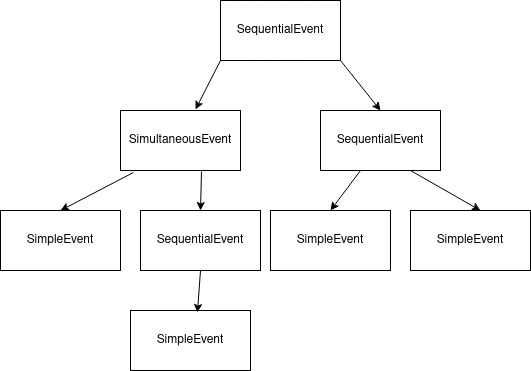Understanding events¶
In mutwo everything is about events. So what is an events? This could be a
tone
melody
video
symphony
light show
…
so literally anything which happens in time, which starts in a moment and ends some times later. mutwo builds on a very generalized model in order to sufficiently represent all those very different manifestations. This model uses a tree-like structure, where some events (as a melody) are composed of smaller events (as tones and rests). This generalized model only needs three different objects to describe all possible cases:
Consecution: a sequence of events (for instance: a melody)Concurrence: a simultaneity of events (for instance: a polyphony)Chronon: an event without children, the leaf or the node of the tree (for instance: a tone)
Those three objects can be combined to build deeply nested structures.

The structure of this graph can be created in mutwo with the following code:
# Initial import of mutwo package
from mutwo import core_events
# Definition of event
event = core_events.Consecution(
[
core_events.Concurrence(
[
core_events.Chronon(1),
core_events.Consecution([core_events.Chronon(1)]),
]
),
core_events.Consecution(
[core_events.Chronon(1), core_events.Chronon(1)]
),
]
)
The duration of an event¶
The number 1 inside the Chronon defines the duration of the event.
The durations of Consecution and Concurrence are dynamically calculated from the duration of their children.
You can find out an events duration by asking for its duration attribute:
>>> event.duration
DirectDuration(duration = 3)
You can also set the duration of your events to a new value:
>>> event.duration = 4
>>> event.duration
DirectDuration(duration = 4)
Children events¶
In order to get, set or delete the children of your event, you can use the standard Python syntax for lists.
>>> # Let's get the first leaf of our event
>>> event[0]
Concurrence([Chronon(duration = DirectDuration(duration = 4/3)), Consecution([Chronon(duration = DirectDuration(duration = 4/3))])])
>>> # We can also get the second leaf of our first leaf
>>> event[0][1]
Consecution([Chronon(duration = DirectDuration(duration = 4/3))])
>>> # Now, let's replace our first leaf by a much simpler structure
>>> event[0] = core_events.Chronon(2)
>>> # And let's check whether it worked
>>> event[0]
Chronon(duration = DirectDuration(duration = 2))
You can also add new events to Consecution and Concurrence by using the append method:
>>> # Let's check the second leaf of our event
>>> event[1]
Consecution([Chronon(duration = DirectDuration(duration = 4/3)), Chronon(duration = DirectDuration(duration = 4/3))])
>>> # And let's add one more Chronon after those two
>>> event[1].append(core_events.Chronon(1))
>>> event[1]
Consecution([Chronon(duration = DirectDuration(duration = 4/3)), Chronon(duration = DirectDuration(duration = 4/3)), Chronon(duration = DirectDuration(duration = 1))])